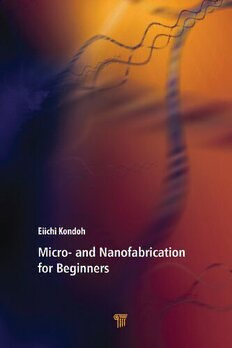Table Of ContentMicro- and Nanofabrication
for Beginners
Micro- and Nanofabrication
for Beginners
Eiichi Kondoh
Publishedby
JennyStanfordPublishingPte.Ltd.
Level34,CentennialTower
3TemasekAvenue
Singapore039190
Email:[email protected]
Web:www.jennystanford.com
BritishLibraryCataloguing-in-PublicationData
AcataloguerecordforthisbookisavailablefromtheBritishLibrary.
Micro-andNanofabricationforBeginners
Copyright(cid:2)c 2021JennyStanfordPublishingPte.Ltd.
Allrightsreserved.Thisbook,orpartsthereof,maynotbereproducedinany
form or by any means, electronic or mechanical, including photocopying,
recordingoranyinformationstorageandretrievalsystemnowknownorto
beinvented,withoutwrittenpermissionfromthepublisher.
For photocopying of material in this volume, please pay a copying
fee through the Copyright Clearance Center, Inc., 222 Rosewood Drive,
Danvers, MA 01923, USA. In this case permission to photocopy is not
requiredfromthepublisher.
Thisbookisbasedontheauthor’spublicationfromKyoritsuShuppanCo.,
Ltd.,Japan,andisfordistributiononlyoutsideJapan.
ISBN978-981-4877-09-1(Hardcover)
ISBN978-1-003-11993-7(eBook)
Contents
Preface xi
1 Introduction 1
1.1 TechnologiesThatUnderlinetheInformationSociety 1
1.2 WorldofMicroandNano 2
1.3 ContentsandConstructionofThisBook 5
2 VacuumandGasKinetics 7
2.1 Introduction 7
2.2 VacuumandEquationofState 7
2.2.1 Vacuum 7
2.2.2 IdealGasesandBehaviorofGases 9
2.3 GasPressureandInternalEnergy 10
2.3.1 GasPressureandSpeedofGasMolecules 11
2.3.2 InternalEnergyofaGas 13
2.4 TotalPressureandPartialPressure 14
2.5 DistributionLawofGasVelocity 16
2.5.1 Maxwell–BoltzmannGasVelocityDistribution 16
2.5.1.1 Meanspeedsandmostprobablespeed 16
2.5.1.2 Meaningofdistributionfunction 18
2.5.2 NumberofMoleculesPassingThroughaUnit
Area 20
2.5.2.1 Fluxofincidentmolecules 20
2.5.2.2 Numberofmoleculespassingthrough
anorifice(inthecaseofmolecular
flow) 22
2.5.2.3 Adsorptionofmoleculesontoclean
surface 23
2.5.2.4 Evaporation 24
vi Contents
2.5.3 CosineLaw 24
2.6 MeanFreePathandCollisionProbability 27
2.6.1 MeanFreePath 27
2.6.2 CollisionProbability 31
2.6.3 MeanFreePathofaGasMixture 32
2.7 FlowofMoleculesUnderVacuum 33
2.7.1 ViscousFlowandMolecularFlow 33
2.7.2 Conductance 34
2.7.3 ConductanceCalculus 35
2.7.4 VacuumFlowRateandPumpingSpeed 37
2.7.5 GasAdmission,PressureRegulation,and
AverageResidenceTime 39
2.8 VacuumEquipments 40
2.8.1 VacuumChamberandPipe/Fitting 40
2.8.2 VacuumPumps 41
2.8.2.1 Generalclassification 41
2.8.2.2 Typesofvacuumpumps 42
2.8.2.3 Introductiontopracticaldesigningof
vacuumpumpingsystems 49
3 FundamentalsofPlasma 55
3.1 Introduction 55
3.2 WhatIsaPlasma? 56
3.2.1 ParticlesinaPlasma 56
3.2.2 MotionofChargedParticlesinan
ElectromagneticField 61
3.2.2.1 Motioninelectricfield 61
3.2.2.2 Conservationofenergy 63
3.2.2.3 Motioninamagneticfield 64
3.3 CollisionofElectronsandMolecules 65
3.3.1 ElasticandInelasticCollisions 65
3.3.2 CollisionProcesses 69
3.3.3 CollisionCrossSection 73
3.4 PlasmaAdjacenttoElectrodes 74
3.5 PlasmaApparatusandtheInteriorofaPlasma 78
3.5.1 DCGlowDischarge 78
3.5.1.1 Plasmaapparatus 78
3.5.1.2 Initiationofdischarge 80
Contents vii
3.5.1.3 StructureofDCglowdischargeand
plasmasustenance 80
3.5.2 RFPlasma 83
3.5.2.1 Principleandsetup 83
3.5.2.2 Self-biasanditsapplications 87
3.5.3 DevelopmentofPlasmaforMicro-and
Nanofabrication 89
3.5.3.1 Inductivelycoupledplasma 90
3.5.3.2 MagneticfieldandECRplasma 90
4 PhysicalVaporDeposition 95
4.1 Introduction 95
4.2 Evaporation 96
4.2.1 EvaporationandDeposition 96
4.2.1.1 Vacuumevaporation 96
4.2.1.2 Vacuumevaporator 96
4.2.1.3 Vaporpressure 98
4.2.1.4 Vaporizationrate 100
4.2.1.5 Depositionrateandfilmuniformity 101
4.2.1.6 Multicomponentdepositionand
impurityincorporation 105
4.2.2 EvaporationSourcesandDerivativeMethods 108
4.2.2.1 Resistiveevaporation 108
4.2.2.2 Electronbeamevaporation 109
4.2.2.3 Reactiveevaporation 110
4.2.2.4 Ionplating 110
4.2.3 FeaturesofVacuumEvaporation 112
4.3 Sputtering 113
4.3.1 PrincipleofSputtering 113
4.3.1.1 Sputteringphenomenon 114
4.3.1.2 Sputteringyield 117
4.3.1.3 Solidangulardistributionofsputtered
particles 119
4.3.1.4 Filmthicknessdistribution 120
4.3.1.5 Propertiesofsputter-depositedfilms 122
4.3.2 SputterDepositionApparatus 124
4.3.2.1 DCsputterapparatusandRFsputter
apparatus 124
viii Contents
4.3.2.2 Magnetronsputtering 124
4.3.3 AppliedSputterDeposition 126
4.3.3.1 Reactivesputtering 126
4.3.3.2 Depositionofalloysandcompounds 127
4.3.3.3 Ionbeamsputtering 129
5 FilmFormationProcess 133
5.1 Introduction 133
5.2 ThinFilmGrowth 133
5.2.1 AtomStackingandDevelopmentofaFilm 133
5.2.2 FilmSurfaces 136
5.3 Nucleation 139
5.3.1 EquilibriumTheory 140
5.3.1.1 Homogeneousnucleation 140
5.3.1.2 Heterogeneousnucleation 141
5.3.1.3 Surfaceandinterfacialenergyand
growthmode 143
5.3.2 KineticsofNucleation 144
5.3.2.1 Adsorptionanddesorption 144
5.3.2.2 Rateofnucleation 145
5.4 DevelopmentofFilmMicrostructures 147
5.4.1 IslandGrowthandCoalescence 147
5.4.2 DevelopmentofPolycrystallineFilmStructures 150
5.4.3 EpitaxialGrowth 153
6 Etching 159
6.1 Introduction 159
6.2 ClassificationofEtching 159
6.3 WetEtching 165
6.3.1 IsotropicEtching 165
6.3.2 AnisotropicEtching 166
6.4 PhysicalDryEtching 168
6.5 ChemicalDryEtching 171
6.5.1 Thermoreactivechemicaletching 171
6.5.2 PlasmaEtching 172
6.5.2.1 SietchingunderF-basedchemistry 174
6.5.2.2 EtchingofSiO andSi N using
2 3 4
fluorinatedgases 175
Contents ix
6.5.2.3 SelectiveetchingSiandSiO 176
2
6.5.3 Photo-AssistedChemicalEtchingandElectric
Charging 178
6.6 PhysicalandChemicalDryEtching 178
6.6.1 Reactive-IonEtching 179
6.6.1.1 PrincipleandapparatusofRIE 179
6.6.1.2 Reactionmechanisms 179
6.6.1.3 Anisotropicetchingbysidewall
protection 182
6.6.2 OtherTypesofIon-AssistedEtching
Techniques 183
6.6.2.1 Reactive-ionbeametching 183
6.6.2.2 Remoteplasmaetching 184
7 Photolithography 189
7.1 Introduction 189
7.2 IntroductiontoPhotolithography 190
7.3 PhotoresistProcess 193
7.3.1 PhotoresistMaterials 194
7.3.2 PhotoresistCoating 195
7.4 Photomask 197
7.4.1 PhotomaskMaterials 197
7.4.2 DesigningPhotomaskPatterns 198
7.5 Exposure 200
7.5.1 Printers 200
7.5.1.1 Contactandproximityprinters 200
7.5.1.2 Projectionprintersandsteppers 201
7.5.2 LightSources 208
AppendixA SymbolsandVariables 211
AppendixB BasicPhysicalConstants 213
AppendixC DevelopmentofFacets 215
Index 219

